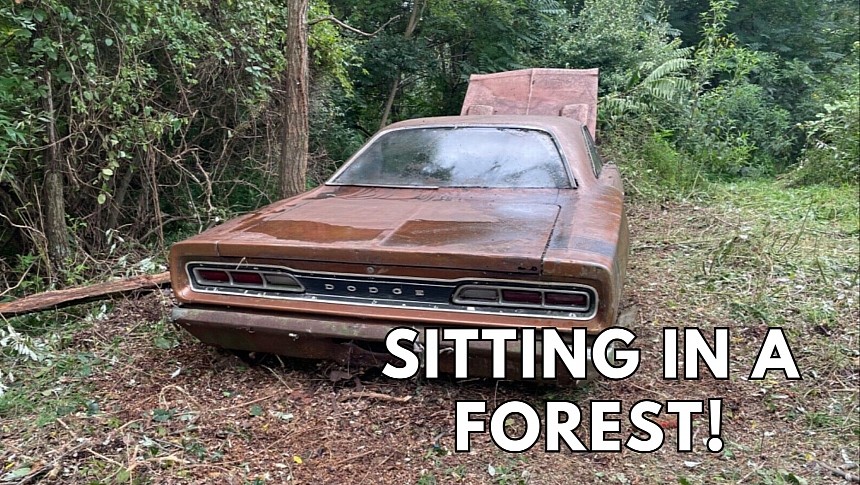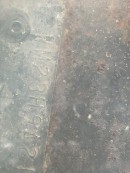The Super Bee is a highly desirable model not only because Dodge produced it for just a few years but also thanks to its muscle appetite, especially when fitted with a Hemi.
For example, the 1969 model year witnessed the debut of a new engine. Dodge introduced the 440 (7.2-liter) Six Pack, which used three two-barrel Holley carburetors. It was rated at 390 horsepower and used the A12 designation in Dodge's nomenclature – you can identify a Super Bee fitted with this engine by the M code in the VIN tag.
According to rough numbers, Dodge produced approximately 27,800 Super Bees for the model year 1969, most coming with the base 383 under the hood. The 440 Six Pack was rarer, as only around 1,900 units rolled off the assembly lines with the new engine. Eventually, Dodge also produced 166 Super Bees with the almighty 426 Hemi.
A 1969 Super Bee born with a 383 is fighting for life in what seems to be a forest, struggling with the invasion of rust and humanity's ignorance.
As a petrolhead, I can't imagine why someone would abandon such a great car. However, what's worse is that the vehicle likely spent decades in the same place, eventually losing some parts, probably in favor of other projects. It now comes without seats and the rear end, eBay seller tohi-9425 explains.
The metal condition isn't as bad as you'd expect, as the body passed the test of time, not with flying colors but in a shape that still allows for complete restoration. We're not getting a closer look at the interior, likely as the seller didn't have the keys (considering the photos made through the side windows), but at least we can check out the V8 under the hood.
The 383 doesn't look good, and I don't expect it to be alive, especially in a car that's been sitting for a long time in nature. The seller didn't share any specifics on the engine, so you'll have to bring a good mechanic to inspect the mechanical part of the car before committing to a purchase. You should also expect plenty of rust on the floors and the trunk.
A 1969 Super Bee is still an intriguing find regardless of its condition, so I believe this car won't remain up for grabs for too long. The seller hopes to get at least $2,000 for it – this is the starting bid. The auction will end in two days.
Interested customers who want to see the Super Bee in person must travel to Parkersburg, West Virginia. And considering the car's condition, a trailer is the only way to take home the car – or, at least, what's left of it.
According to rough numbers, Dodge produced approximately 27,800 Super Bees for the model year 1969, most coming with the base 383 under the hood. The 440 Six Pack was rarer, as only around 1,900 units rolled off the assembly lines with the new engine. Eventually, Dodge also produced 166 Super Bees with the almighty 426 Hemi.
A 1969 Super Bee born with a 383 is fighting for life in what seems to be a forest, struggling with the invasion of rust and humanity's ignorance.
As a petrolhead, I can't imagine why someone would abandon such a great car. However, what's worse is that the vehicle likely spent decades in the same place, eventually losing some parts, probably in favor of other projects. It now comes without seats and the rear end, eBay seller tohi-9425 explains.
The metal condition isn't as bad as you'd expect, as the body passed the test of time, not with flying colors but in a shape that still allows for complete restoration. We're not getting a closer look at the interior, likely as the seller didn't have the keys (considering the photos made through the side windows), but at least we can check out the V8 under the hood.
The 383 doesn't look good, and I don't expect it to be alive, especially in a car that's been sitting for a long time in nature. The seller didn't share any specifics on the engine, so you'll have to bring a good mechanic to inspect the mechanical part of the car before committing to a purchase. You should also expect plenty of rust on the floors and the trunk.
A 1969 Super Bee is still an intriguing find regardless of its condition, so I believe this car won't remain up for grabs for too long. The seller hopes to get at least $2,000 for it – this is the starting bid. The auction will end in two days.
Interested customers who want to see the Super Bee in person must travel to Parkersburg, West Virginia. And considering the car's condition, a trailer is the only way to take home the car – or, at least, what's left of it.













